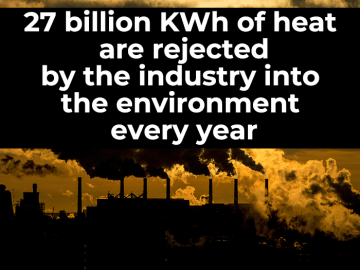27 billion KWh of heat are rejected by the industry into the environment every year - Circular economy can use this heat
Recovering only 20% of this heat will avoid 3 billion tons of CO2 emission every year.
PARIS, FRANCE, April 5, 2023/EINPresswire.com/ — According to the International Energy Agency (IEA), the total final consumption of thermal heat for industrial purposes is approximately 58 terawatt hours (TWh). Let us recall that approximately 50% of this thermal heat is not used and is rejected into the environment.
Also according to the (IEA), the average CO2 emission is approximately 0.5 tons of CO2 per MWh.

Therefore, the total amount of CO2 produced would be approximately: 57,476 TWh x 1,000,000 MWh/TWh x 0.5 tons CO2/MWh = 28.74 billion tons of CO2.
Being aware of the long term ahead for installing renewable technologies, what can we propose, as realistic actions, for effective short terms solutions?
PARIS, FRANCE, April 5, 2023/EINPresswire.com/ — According to the International Energy Agency (IEA), the total final consumption of thermal heat for industrial purposes is approximately 58 terawatt hours (TWh). Let us recall that approximately 50% of this thermal heat is not used and is rejected into the environment.
Also according to the (IEA), the average CO2 emission is approximately 0.5 tons of CO2 per MWh. Therefore, the total amount of CO2 produced would be approximately: 57,476 TWh x 1,000,000 MWh/TWh x 0.5 tons CO2/MWh = 28.74 billion tons of CO2.
Being aware of the long term ahead for installing renewable technologies, what can we propose, as realistic actions, for effective short terms solutions?
We can quickly use, on the one hand, the heat in the circular economy and, on the other hand, avoid the generation of new pollution. Of course, the idea is not new. What is new is that a new tool, that has been searched for during over 150 years, is available today for extending the possibilities of the heat reuse. It is the continuous flash evaporation of heated water in a simple reservoir invented by Professor Dr. Alain Elayi. It is particularly interesting in situations where heat recovery is difficult to achieve or when we have low grade rejected heat. If handled properly, this new tool produces a huge economic impact. A case study in sea water desalination illustrate the new possibilities that this new tool offers.
The wasted heat reuse in sea water desalination can participate in solving the water crises. This new desalination technology is called MUDT (Multitasking Unconventional Desalination Technology). It has been patented by main industrial countries such as USA, China, India, European EPO, Australia, Japan… Even though MUDT is presented as a standalone optimized technology with its own breakthroughs, it is a part of the larger program of the wasted heat reuse. This is a link to the YouTube channel of MUDT :
https://www.youtube.com/@mudt-Scientechnix
About Prof. Dr. Alain Elayi: Renowned Physicist, Professor Dr. Alain Elayi worked with major institutes and nuclear companies such as EDF and Electrabel. He invented a method to recycle a part of the 70 billion KWh of heat rejected each day into the environment. He developed MUDT in order to use an ecofriendly and affordable desalination technology.
Personal website http://alain-elayi.com
About Scientechnix: Created in 1990 Scientechnix is a research company devoted to industrial applications. All the company’s income was devoted to research, making it a non-profit organization in all but in his name until the invention of MUDT his last achievement. https://scientechnix.com
Professor Dr. Alain Elayi
Scientechnix
+33 1 85 54 00 92
email us here
Visit us on social media:
YouTube
